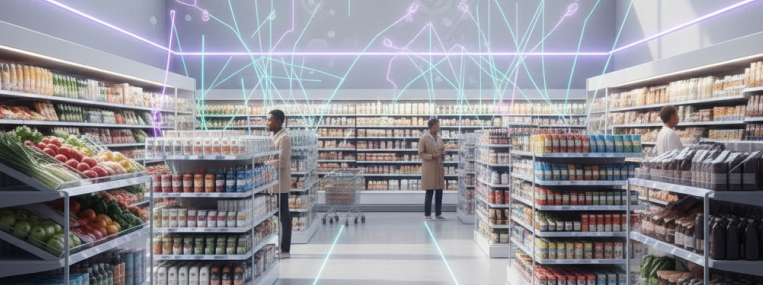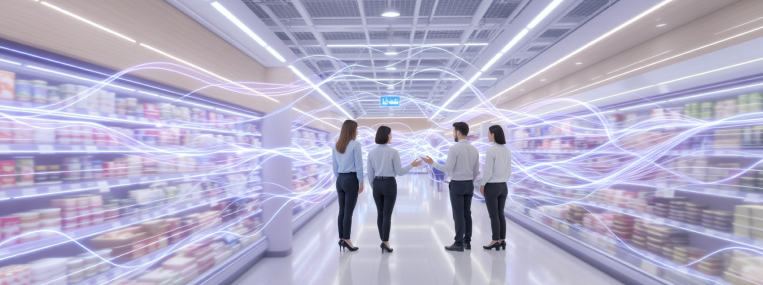Pennies That Protect Millions: Detecting Margin Leakage in Grocery Pricing
Pennies That Protect Millions: Detecting Margin Leakage in Grocery Pricing
In grocery retail, profitability is built on precision. Margins are often razor thin, and every cent counts. Yet, in a world of thousands of SKUs, daily price changes, and complex promotions, even minor inefficiencies can quietly erode profits. These small, often unnoticed errors can accumulate into what the industry calls margin leakage, the gradual loss of profit through pricing inconsistencies, delayed updates, and execution gaps.

For grocery leaders focused on volume and velocity, these micro errors are easy to overlook. A single mispriced item or an outdated promotion might seem trivial in isolation, but across hundreds of stores and tens of thousands of SKUs, those pennies can add up to millions in lost revenue over a year.
The challenge lies in visibility. Traditional systems lack the intelligence to detect these small, silent leaks before they become significant. But with the right technology, every price can be tracked, verified, and optimized in real time. This is where Hypersonix Pricing AI and Price Execution Monitoring come in, turning precision into profit and bringing margin discipline back into grocery pricing.
To understand how grocery retailers lose margin in small increments, it’s essential to first look at how operational complexity creates invisible cracks in the system.
The Hidden Nature of Margin Leakage in Grocery
In grocery operations, the pace of change is relentless. Prices fluctuate daily due to supplier costs, promotions, or competitive pressures. Grocers manage thousands of SKUs across perishable, seasonal, and packaged categories, each with its own pricing cadence. Amid this complexity, even small mismatches between planned and executed prices can distort margins.
For example, a grocery chain might plan to increase prices on dairy products due to rising supplier costs. But if updates fail to sync across all stores or marketplaces at the same time, some locations may continue selling at the old price for hours or even days. The difference might be just a few cents per unit, but multiplied across volume and time, it becomes a measurable loss.

Another common issue is in promotional execution. A “Buy One Get One” offer that extends beyond its intended date, or a digital coupon that overlaps with an in-store discount, can double-dip margins unintentionally. Similarly, regional pricing variations meant to match local competition can drift apart over time without ongoing validation.
These small lapses do not trigger alarms because they blend into the day-to-day rhythm of grocery operations. Yet, collectively, they represent a silent drain on profitability. Traditional audit systems, which check prices weekly or monthly, simply cannot catch them fast enough.
The result is a growing gap between pricing strategy and real-world execution, a gap that widens with scale and speed. That is where AI provides the precision and real-time visibility grocery retailers have long needed.
These invisible leaks might seem inevitable in complex operations, but they persist mainly because traditional pricing systems were never built to detect them quickly or accurately.
Why Traditional Systems Struggle to Catch These Leaks
Traditional grocery pricing workflows rely heavily on manual audits, rule-based systems, and reactive decision-making. These methods were built for an era when price changes were infrequent and competition was local.
Today, grocery pricing has evolved into a dynamic, data-heavy discipline. Prices shift multiple times a week. Promotions overlap across digital and physical stores. Competitor prices can change hourly. Managing this volume manually is nearly impossible.
Three fundamental gaps keep traditional systems from detecting margin leakage effectively:
-
Limited Speed: Price audits are periodic, not continuous. Issues can persist unnoticed for days or weeks before they are corrected.
-
Fragmented Data: Online, in-store, and third-party marketplace systems often operate separately, creating inconsistencies that customers and teams cannot see in real time.
-
Lack of Context: Even when discrepancies are identified, teams often lack insights into why they happened or how much financial impact they have caused.
In short, human-led monitoring cannot keep pace with the speed and scale of modern grocery pricing. Retailers need systems that can track, detect, and explain anomalies in real time, which is precisely where Hypersonix AI delivers value.
This growing disconnect between pricing strategy and execution demands a smarter approach. That’s where artificial intelligence brings the visibility, speed, and precision needed to close the gap.
How Hypersonix Detects Margin Leakage Before It Hurts Profit
Hypersonix Pricing AI and Price Execution Monitoring work together to close the gap between pricing strategy and execution. Using real-time data, automation, and explainable intelligence, Hypersonix continuously identifies inefficiencies and prevents them from becoming losses.

Here’s how it enables grocery retailers to detect and control silent margin killers:
-
Real-Time Price Validation
Instead of relying on scheduled checks, Hypersonix continuously monitors live pricing data across all stores, channels, and digital platforms. It instantly flags discrepancies between approved pricing and what customers actually see. For instance, if an in-store kiosk shows one price while the online store displays another, Hypersonix detects the mismatch and alerts teams immediately, ensuring pricing consistency across every touchpoint. -
Promotion Oversight and Alignment
Promotions are critical to grocery growth, but they are also a major source of leakage. Hypersonix reviews ongoing offers against their intended duration, depth, and applicable SKUs. If a campaign runs past its end date or overlaps with another discount, the system identifies it in real time, allowing teams to intervene before margins suffer. -
Competitor and Market Awareness
Not all inefficiencies are internal. Sometimes, external competitive shifts cause reactive pricing errors. Hypersonix Competitor AI tracks competitors’ pricing and promotional activity daily, ensuring retailers do not overreact to short-lived market changes. This context prevents margin dilution caused by unnecessary price drops. -
Explainable Intelligence and Root-Cause Analysis
Every alert from Hypersonix comes with explainable context. Teams can see the reason behind each detected issue — whether it’s a sync delay, a misconfigured promotion, or competitive noise — and quantify its potential impact. This transparency transforms detection into learning, helping retailers refine workflows and prevent recurrence.
With these capabilities, Hypersonix enables grocery retailers to maintain price integrity at scale, turning potential losses into controlled, data-backed decisions.
But detection alone is not enough. For long-term margin protection, the system must also ensure that insights translate into immediate, corrective action.
From Detection to Correction: Closing the Pricing Loop
Finding errors is only the first step. Acting on them quickly is what truly preserves profitability. Hypersonix achieves this through agentic workflows that automate follow-up actions while keeping pricing teams in control.
When a discrepancy is identified, the system suggests corrective steps such as syncing updates, ending overlapping promotions, or revalidating category rules. These recommendations are reviewed and approved by pricing managers through explainable dashboards, ensuring accountability and speed.
This closed-loop approach transforms margin recovery from a manual, reactive process into a continuous improvement cycle. Pricing teams spend less time investigating errors and more time optimizing strategy.
As these real-time corrections take effect, pricing accuracy improves, but there’s another layer of value that emerges, cleaner data and stronger predictive insights.
Elasticity Integrity: Keeping Data Clean for Smarter Decisions
Margin leakage does more than reduce profit, it also distorts the analytics behind pricing decisions. When execution errors persist, they pollute the historical data that AI models use to measure elasticity.
For example, if a discount lasts longer than intended, the system might interpret the inflated sales as a signal of higher price sensitivity, when in reality, it was a promotional artifact. Similarly, underpriced SKUs can create false demand spikes that skew future recommendations.
By continuously validating execution, Hypersonix preserves the integrity of elasticity data. This ensures that all future pricing decisions are grounded in accurate, unbiased behavioral patterns, allowing retailers to optimize prices confidently without overcompensating for past errors.
Yet precision alone isn’t enough. For teams to act confidently on AI-driven recommendations, they must fully understand the reasoning behind them.
Building Trust Through Explainable AI
For grocery teams to rely on automation, they must trust it. Hypersonix builds that trust through explainable AI, which clearly shows the reasoning behind every alert or recommendation.
When a price misalignment is detected, managers can see the exact cause — such as a sync delay between the ERP and eCommerce platform or a mismatch in regional pricing logic, along with its financial implications. This level of transparency allows cross-functional teams, from merchandising to finance, to collaborate using the same source of truth.
Explainability turns AI from a mysterious algorithm into a trusted decision partner, fostering both confidence and accountability in pricing operations.

Once trust in automation is established, organizations can move from reactive problem-solving to proactive excellence, turning precision into a competitive advantage.
From Leakage to Leadership: Building a Culture of Pricing Precision
AI does more than plug leaks, it transforms how grocery retailers think about pricing altogether. By automating the detection of small inefficiencies, Hypersonix enables teams to focus on higher-value decisions like strategic price positioning and customer experience.
Over time, the organization develops a culture of precision, where every SKU, every promotion, and every update is managed with discipline. Instead of reacting to errors, teams proactively refine their pricing ecosystems.
The result is not just higher profitability but greater resilience. Grocers that master execution integrity can respond faster to market changes, maintain customer trust, and reinvest recovered margins into growth and innovation.
The lesson is clear: eliminating silent margin killers is not just a technical fix, it’s a cultural shift toward operational precision and profit discipline.
Conclusion
In grocery pricing, profit is not lost in grand gestures but in the smallest inconsistencies. Those unnoticed discrepancies — a delayed update, a lingering discount, a mismatched price tag, quietly drain millions in potential profit.
With Hypersonix Pricing AI and Price Execution Monitoring, grocery retailers can finally bring those invisible losses into the light. Through real-time detection, explainable insights, and agentic correction, they can ensure that every price reflects intent, every promotion runs precisely as planned, and every penny is protected.
In an industry where margins are measured in basis points, precision is power. The future of grocery profitability belongs to retailers who can see, understand, and control every detail of their pricing execution. With Hypersonix, that future starts now.






